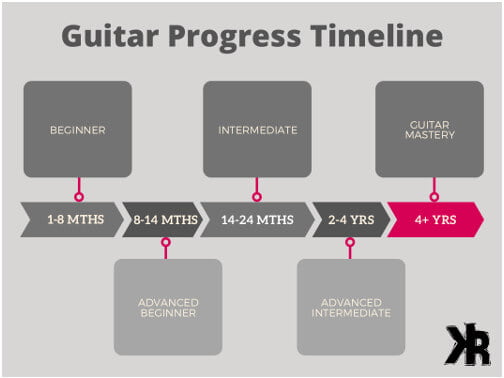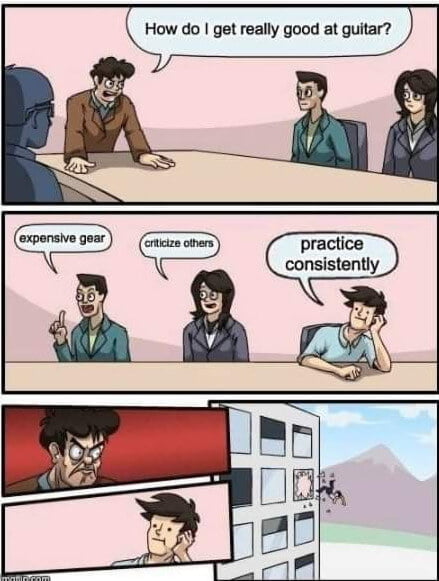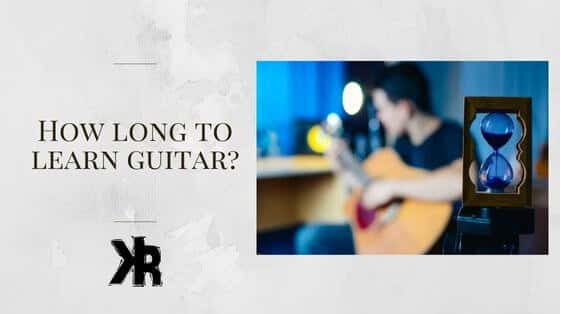Table of Contents
So if you’re here, then I know you’re wondering, “How long does it take to learn guitar?” Well, it’s not a one-answer-fits-all kind of scenario. Picking up a guitar and actually getting good at it is different for everyone.
Learning guitar is about more than memorizing chords or plucking strings, it’s about understanding the music, the instrument, and your relationship with both. But don’t worry, we’re in this together!
In this Killer Rig article, we’re going to lay it all out for you. We’ll talk about what can make you learn faster or slower, the different levels you’ll hit as you get better, and some solid tips to make your practice count.
Key Takeaways
Time to Master Beginner Level
- With over 150 hours of practice, you can play simple songs.
- College students can hit this mark over summer break.
- Busy professionals need about 10 months with daily 30-minute sessions.
- For medium-intensity practice, 3–5 days a week, expect 1–2 months to play beginner songs.
Progressing to Intermediate Level
- Takes 3–6 months to play intermediate songs with some technical elements.
- This is when you dive into technique and basic music theory.
- You’ll learn advanced strum patterns, hammer-ons, and trickier plucking.
- Good time to start reading guitar tabs and music.
Reaching Advanced Level
- You’ll have a deep understanding of feel, tone, and dynamics.
- Time to reach this level varies widely: 2 to nearly 10 years.
- The speed depends on how intensely you practice.
The Fundamentals: Beginning Guitar
The first chord you strum, the song you play, and the instrument you own, these are all milestones in your journey as a guitarist. These beginning stages set the foundation for everything to come.
Choosing the Right Guitar for Yourself
The first step is choosing your instrument. There’s a world of difference between acoustic, electric, and classical guitars, and your choice depends on your musical preferences. Acoustic guitars are versatile and great for singer-songwriters.
Electric guitars, with their distinct tone, are perfect for rock, blues, and metal. Classical guitars, with their nylon strings, are ideal for fingerstyle and classical music.
Your choice also depends on your comfort. Pay attention to the guitar’s size, weight, and the thickness of the neck. Remember, the guitar is an extension of yourself, so it should feel right in your hands.
Setting Goals: The Importance in Your Journey
As with any endeavor, setting clear, achievable goals is crucial in your guitar journey. Your goals might start small, learning to play a single chord or a favorite song.
As you progress, your goals will become more ambitious. This will include mastering complex techniques, improvising solos, or even writing your own music.
Goals give you a sense of direction and a way to measure your progress. They keep you motivated during challenging times and celebrate your successes. But remember, the aim is not to compare yourself with others but to improve upon your past self.
Introductory/Basic/Beginning Techniques
Now, to the actual playing. Begin with learning the open chords. These are the building blocks of countless songs. Practice changing between chords smoothly and maintaining consistent rhythm.
Start familiarizing yourself with basic strumming patterns and, when you’re ready, start picking individual strings. Try your hand at simple songs that use the chords and strumming patterns you’ve learned. This not only makes practice fun but also gives you a sense of accomplishment early on.
Learning guitar requires patience and consistency. There will be calluses, and there will be frustration! But remember, every great guitarist started right where you are. Keep going, stay dedicated, and soon, you’ll see yourself grow as a musician.

The Self-Taught Route: Learning Guitar by Yourself
Venturing into the world of guitar on your own can be a thrilling yet challenging endeavor. The freedom to explore at your own pace coupled with the responsibility of self-discipline paints a unique picture of growth.
How Long Does It Take to Learn Guitar by Yourself?
The timeline for self-taught guitar learning isn’t set in stone. It depends on various factors such as your dedication, practice time, and innate musicality. A diligent learner practicing daily might grasp the basics within a few months.
However, developing proficiency and comfort with the instrument usually takes a couple of years. Remember, this journey isn’t a race. The goal is progress, not perfection.
Useful Tips to Keep in Mind for Self-Learners
As a self-learner, maintaining a consistent practice routine is crucial. Aim for regular, shorter practice sessions over sporadic, longer ones. Use resources wisely, online tutorials, guitar learning apps, and even social media communities can be immensely helpful.
Understanding music theory might seem daunting, but it’s a powerful tool in your learning arsenal. Knowing how chords, scales, and melodies interact will deepen your understanding of the instrument and the music you play.
What About Naturally Gifted Players?
Talent can provide a head start, but without consistent practice and perseverance, it doesn’t guarantee success. Many ‘gifted’ players might pick up the basics quickly, but the road to true mastery is paved with hours of dedicated practice.
Talent might make the journey smoother, but hard work and dedication are the real drivers on the road to guitar proficiency.
Learning guitar by yourself is a journey of self-discovery. It’s filled with moments of triumph, instances of doubt, and a lot of learning.
Pushing Your Boundaries: Intermediate Guitar
Once you’ve got a grasp on the basics, it’s time to venture into more challenging territories. The intermediate stage is where you start exploring different genres, complex techniques, and start developing your unique style.
The Transition from Beginner to Intermediate
The leap from beginner to intermediate is more than just learning new chords or songs. It’s about increasing your musical understanding, improving your technical skills, and starting to express yourself creatively through your instrument.
This transition happens gradually. You might find yourself playing barre chords with ease, improvising over a backing track, or even transcribing your favorite songs. These are signs that you’re entering the intermediate stage. A stage that broadens your musical horizons and sharpens your guitar skills.
How to Minimize the Time It Takes to Level Up Your Skills?
Improving your skills efficiently requires strategic practice. Focus on areas that challenge you! Be it barre chords, fast solos, or complex rhythms. Divide your practice time between technique, theory, and creative exploration to ensure a well-rounded development.
Use a metronome to improve your timing and gradually increase your speed. Record your practice sessions to identify areas for improvement. And most importantly, make sure your practice is consistent. It’s better to practice for a short time every day than for several hours once a week.
The intermediate stage is a critical phase in your guitar journey. It’s where you start to find your voice as a guitarist. So, embrace the challenges, celebrate your progress, and keep strumming. The world of advanced guitar playing is just around the corner.
Chasing Mastery: Advanced Guitar
Once you’ve navigated the winding roads of the intermediate level, you’ll find yourself at the foot of a new mountain! The pursuit of mastery. The advanced stage is where you polish your skills, dive deeper into the nuances of your instrument, and truly start to express your musical vision.
How Long Does It Take to Master Guitar?
Mastering the guitar is a long-term commitment. For most, it takes several years of dedicated practice and exploration to reach a level where they can play complex pieces with ease, improvise fluently, and express themselves freely through their instrument.
However, remember that ‘mastery’ is a journey, not a destination. Even the most skilled guitarists continue to learn, evolve, and refine their craft.
Can I Master Guitar in 3 Months? Debunking Myths
The short answer is no, you can’t. The myth of mastering guitar in a short time undermines the complexity and depth of the instrument.
It’s possible to make significant progress with intensive practice. But true mastery involves a deep understanding of music theory, technical proficiency, and expressive playing, which takes time to develop.
The advanced stage is all about refining your skills and deepening your musical understanding. It’s where your unique voice starts to shine through your playing. It requires patience, dedication, and a deep love for the guitar.
But remember, the journey is just as beautiful as the destination. Keep pushing your limits, exploring new musical territories, and most importantly, enjoying the beautiful journey of guitar playing.
| Stage | Approximate Timeline | Skill Benchmarks |
|---|---|---|
| Beginner | 3-6 months | Basic open chords, simple strumming patterns, playing simple songs |
| Intermediate | 6 months – 2 years | Barre chords, scales, improvisation, understanding of music theory |
| Advanced | 2 years and beyond | Complex techniques, mastery of scales, advanced improvisation, performance-ready |
The Art of Speed: Tips for Learning to Play Faster
As you advance in your guitar journey, you may aspire to increase your playing speed. Whether it’s to nail that rapid-fire solo or to breeze through complex chord progressions! Playing faster is a skill that can add a new dimension to your performances.
Here are some techniques to help increase your playing speed:
Start Slow and Gradual
Ironically, the key to playing fast is starting slow. Begin by practicing your scales, licks, or chord progressions at a comfortable speed where you can play each note clearly and accurately.
Use a Metronome
A metronome is your best friend when working on speed. Start at a slow tempo and gradually increase it as your comfort and accuracy improve. This ensures your speed increase doesn’t compromise your timing or accuracy.
Focus on Economy of Motion
Minimize unnecessary movements. Your fingers should be close to the fretboard, and your pick strokes should be efficient. The less distance your fingers and pick have to travel, the faster you’ll be able to play.
Regular Practice
Consistency is key when developing speed. Regular, focused practice sessions will yield better results than infrequent, lengthy ones.
Stay Relaxed
Tension is the enemy of speed. Ensure your hands, fingers, and body are relaxed when playing. If you feel any strain, take a break and shake it off.
Remember, speed should never come at the expense of accuracy or musicality. It’s a tool to express your music more effectively, not the end goal. So, practice diligently, stay patient, and soon, you’ll see your speed improve.

From Bedroom to Stage: Preparing for Performance
After hours of practice, mastering new skills, and honing your style, you might feel ready to take the leap from playing in your bedroom to performing on a stage. This transition is an exhilarating milestone in your guitar journey.
Professionals: A Look at Their Journey and Timeline
Every professional guitarist has a unique story, but they all share common themes. This includes years of practice, overcoming challenges, and a relentless passion for music.
The timeline to professional status varies widely. Some may start gigging in a few years, while others might take a decade or more to feel ready. Remember, it’s not a race, but a personal journey.
Gig Dynamics: The Best Time to Play on Stage?
When it comes to performing, there’s no ‘one-size-fits-all’ best time. It depends on your comfort, the venue, the audience, and the nature of the gig.
However, understanding the dynamics of different gig times is crucial. Earlier slots often mean a more relaxed crowd. While prime-time slots come with higher energy levels.
Never Stop Learning
Even when you start performing, remember that you never stop learning. Every gig, rehearsal, and jam session is an opportunity to learn and grow. Stay open to feedback, learn from your mistakes, and always strive to be better than your last performance.
Stepping on stage for the first time can be nerve-wracking, but it’s also a thrilling experience that signifies your progress. So, take a deep breath, tune up your guitar, step into the spotlight, and let your music speak. After all, this is what all those hours of practice were for.
Conclusion
Embarking on the journey of learning guitar is a thrilling venture. Every stage, from your first chord to your opening gig, paints a unique stroke on the canvas of your musical expression.
Through challenges and triumphs, remember that the rhythm of learning never ceases. Keep strumming, exploring, and let your music resonate with your progress. After all, the guitar doesn’t just make melodies, it creates musicians.
FAQs
How can I take care of my guitar to ensure it stays in good condition?
Proper maintenance of your guitar is essential to ensure its longevity and sound quality. Regularly clean your guitar with a soft, dry cloth to remove dust and grime.
Store it in a hard case and keep it in a room with stable temperature and humidity. Changing strings periodically is also important for maintaining the sound quality. Lastly, consider a professional setup every once in a while to ensure optimal playability.
What are some good resources for learning guitar?
There are a plethora of resources available for learning guitar. Online platforms like YouTube have countless tutorials for beginners to advanced players. Websites like Ultimate Guitar or offer a vast library of tabs and chords.
Apps like Yousician and Fender Play provide interactive lessons. Additionally, books on music theory and guitar techniques can be invaluable resources.
How can I prevent and manage finger pain while learning guitar?
Finger pain is common when starting to learn guitar due to the pressure required to fret the strings. To prevent this, start with shorter practice sessions and gradually increase the duration.
Make sure your guitar’s action (the distance between the strings and the fretboard) is not too high, as this can make fretting more difficult. Warm up your fingers before practicing and take breaks when needed. Over time, your fingers will develop calluses, reducing the discomfort.

